Mental Health | Use of Sedatives in Psychiatric Facilities
VerifiedAdded on 2022/08/26
|11
|3131
|32
AI Summary
Contribute Materials
Your contribution can guide someone’s learning journey. Share your
documents today.
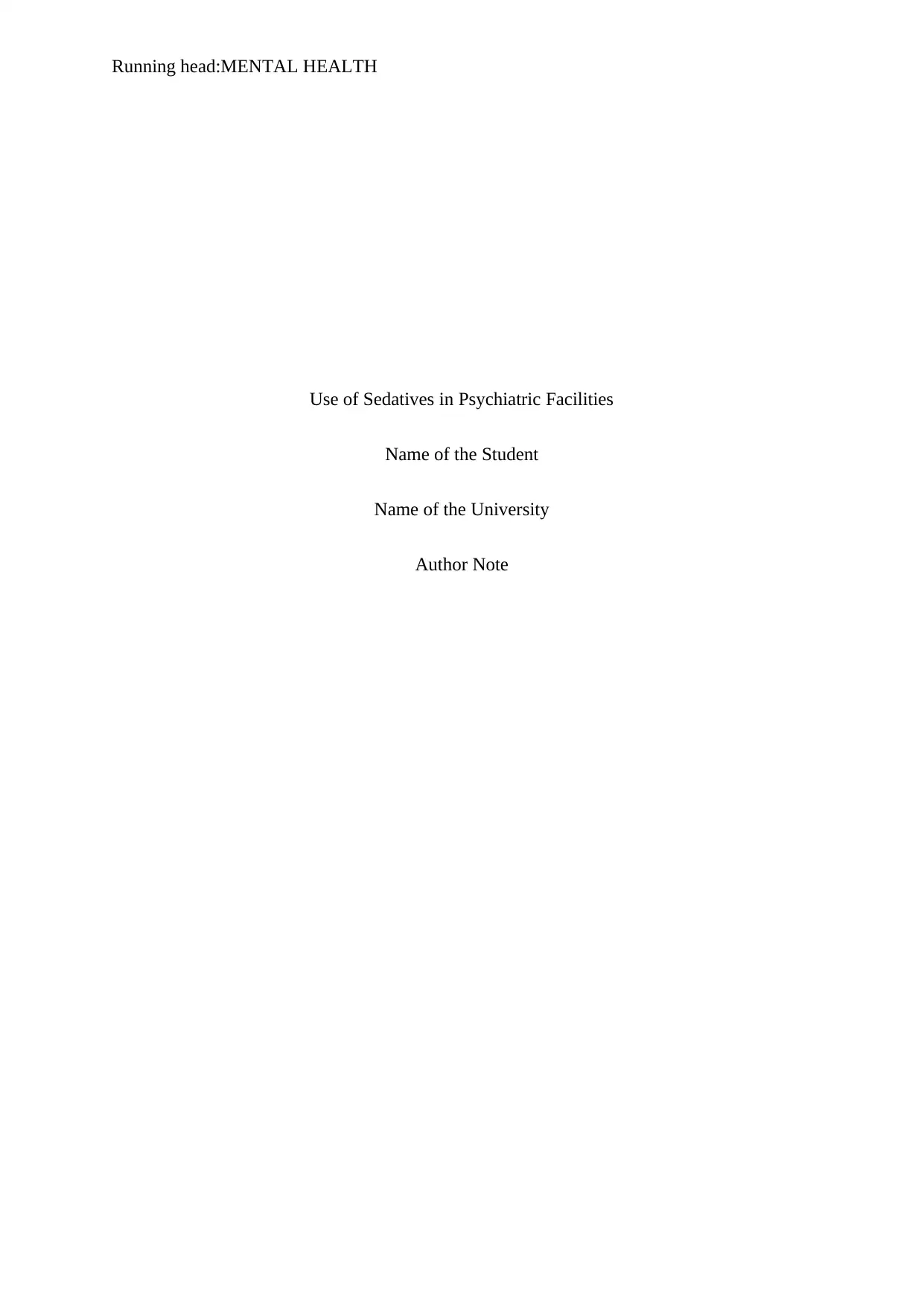
Running head:MENTAL HEALTH
Use of Sedatives in Psychiatric Facilities
Name of the Student
Name of the University
Author Note
Use of Sedatives in Psychiatric Facilities
Name of the Student
Name of the University
Author Note
Secure Best Marks with AI Grader
Need help grading? Try our AI Grader for instant feedback on your assignments.
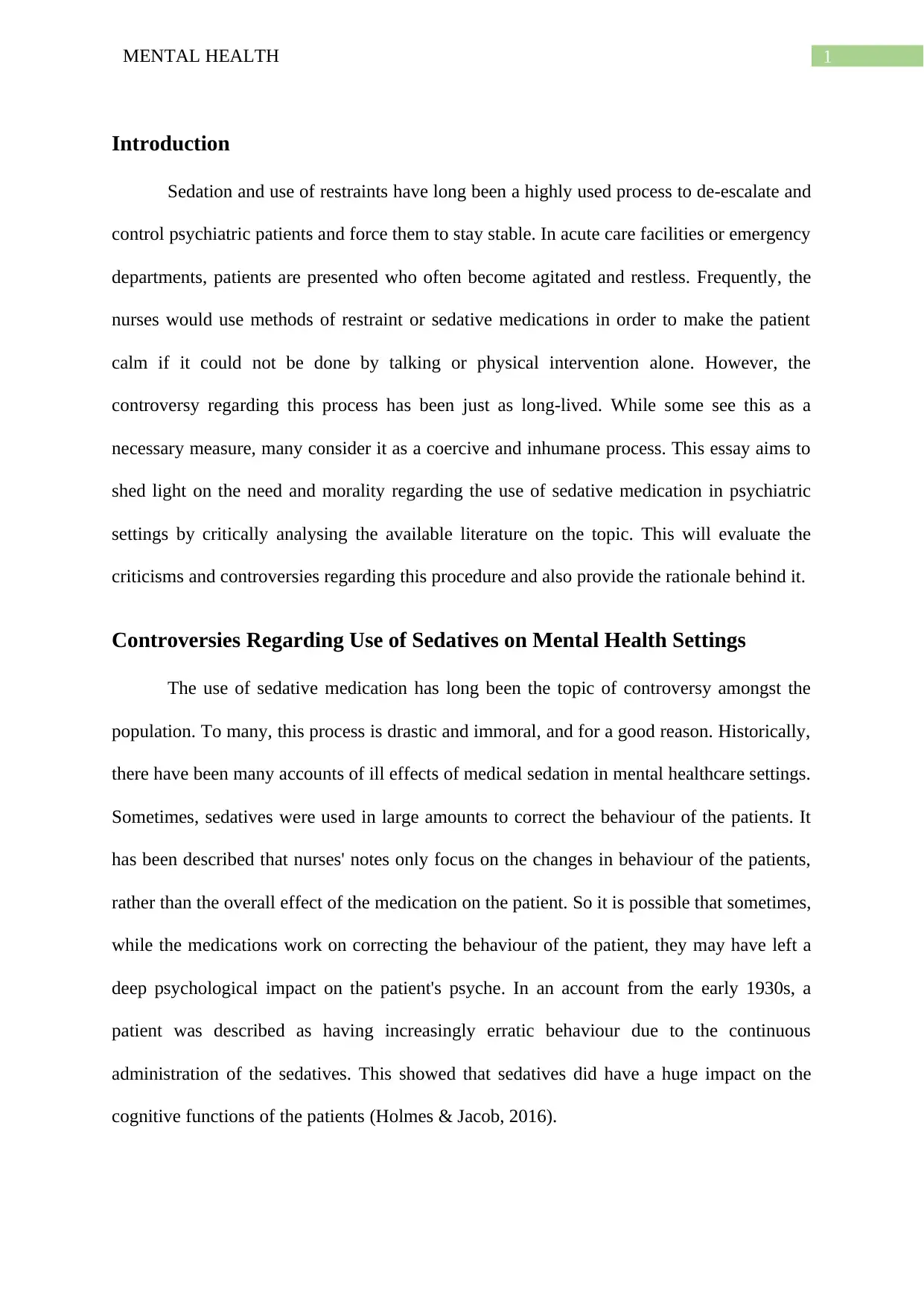
1MENTAL HEALTH
Introduction
Sedation and use of restraints have long been a highly used process to de-escalate and
control psychiatric patients and force them to stay stable. In acute care facilities or emergency
departments, patients are presented who often become agitated and restless. Frequently, the
nurses would use methods of restraint or sedative medications in order to make the patient
calm if it could not be done by talking or physical intervention alone. However, the
controversy regarding this process has been just as long-lived. While some see this as a
necessary measure, many consider it as a coercive and inhumane process. This essay aims to
shed light on the need and morality regarding the use of sedative medication in psychiatric
settings by critically analysing the available literature on the topic. This will evaluate the
criticisms and controversies regarding this procedure and also provide the rationale behind it.
Controversies Regarding Use of Sedatives on Mental Health Settings
The use of sedative medication has long been the topic of controversy amongst the
population. To many, this process is drastic and immoral, and for a good reason. Historically,
there have been many accounts of ill effects of medical sedation in mental healthcare settings.
Sometimes, sedatives were used in large amounts to correct the behaviour of the patients. It
has been described that nurses' notes only focus on the changes in behaviour of the patients,
rather than the overall effect of the medication on the patient. So it is possible that sometimes,
while the medications work on correcting the behaviour of the patient, they may have left a
deep psychological impact on the patient's psyche. In an account from the early 1930s, a
patient was described as having increasingly erratic behaviour due to the continuous
administration of the sedatives. This showed that sedatives did have a huge impact on the
cognitive functions of the patients (Holmes & Jacob, 2016).
Introduction
Sedation and use of restraints have long been a highly used process to de-escalate and
control psychiatric patients and force them to stay stable. In acute care facilities or emergency
departments, patients are presented who often become agitated and restless. Frequently, the
nurses would use methods of restraint or sedative medications in order to make the patient
calm if it could not be done by talking or physical intervention alone. However, the
controversy regarding this process has been just as long-lived. While some see this as a
necessary measure, many consider it as a coercive and inhumane process. This essay aims to
shed light on the need and morality regarding the use of sedative medication in psychiatric
settings by critically analysing the available literature on the topic. This will evaluate the
criticisms and controversies regarding this procedure and also provide the rationale behind it.
Controversies Regarding Use of Sedatives on Mental Health Settings
The use of sedative medication has long been the topic of controversy amongst the
population. To many, this process is drastic and immoral, and for a good reason. Historically,
there have been many accounts of ill effects of medical sedation in mental healthcare settings.
Sometimes, sedatives were used in large amounts to correct the behaviour of the patients. It
has been described that nurses' notes only focus on the changes in behaviour of the patients,
rather than the overall effect of the medication on the patient. So it is possible that sometimes,
while the medications work on correcting the behaviour of the patient, they may have left a
deep psychological impact on the patient's psyche. In an account from the early 1930s, a
patient was described as having increasingly erratic behaviour due to the continuous
administration of the sedatives. This showed that sedatives did have a huge impact on the
cognitive functions of the patients (Holmes & Jacob, 2016).
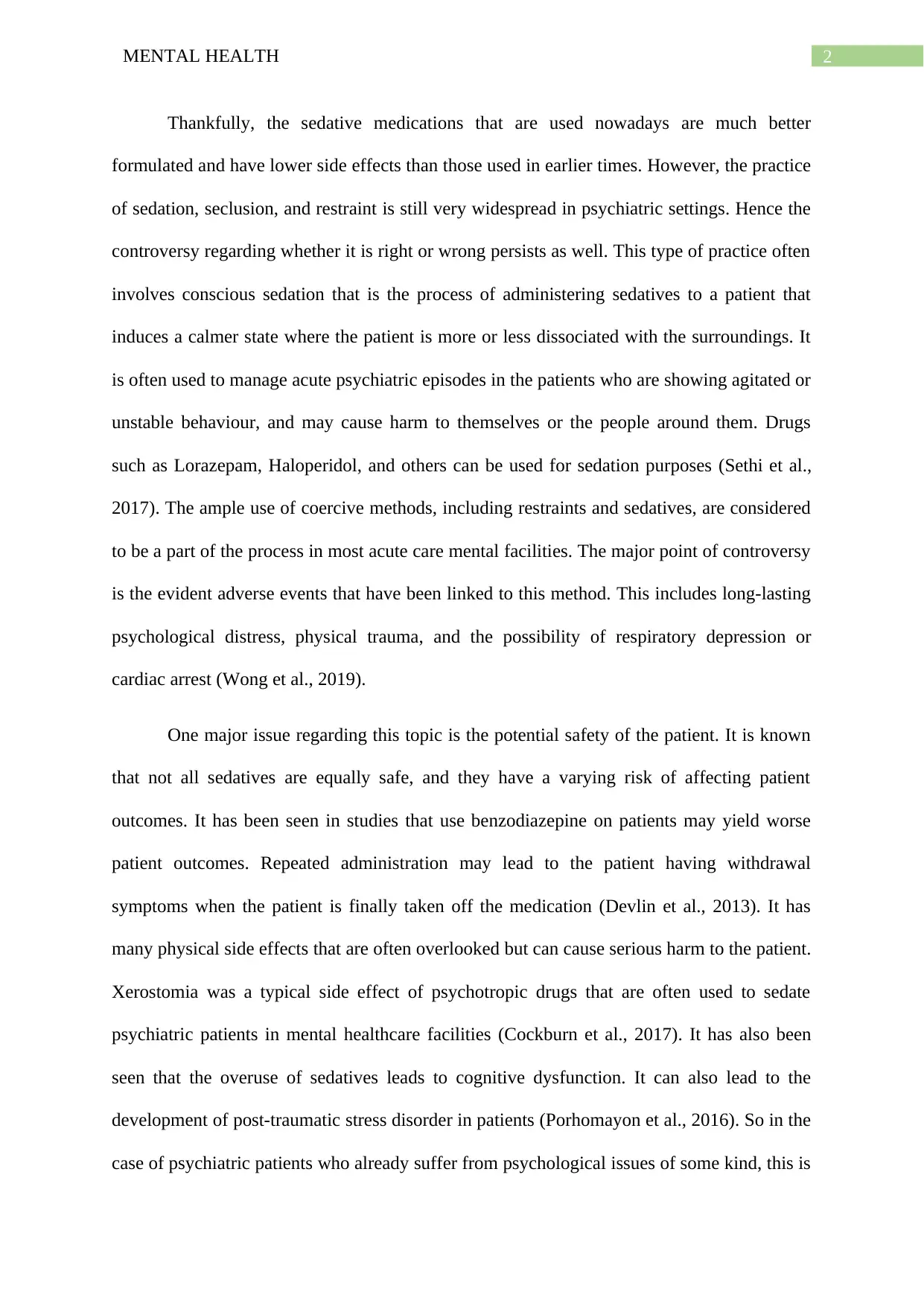
2MENTAL HEALTH
Thankfully, the sedative medications that are used nowadays are much better
formulated and have lower side effects than those used in earlier times. However, the practice
of sedation, seclusion, and restraint is still very widespread in psychiatric settings. Hence the
controversy regarding whether it is right or wrong persists as well. This type of practice often
involves conscious sedation that is the process of administering sedatives to a patient that
induces a calmer state where the patient is more or less dissociated with the surroundings. It
is often used to manage acute psychiatric episodes in the patients who are showing agitated or
unstable behaviour, and may cause harm to themselves or the people around them. Drugs
such as Lorazepam, Haloperidol, and others can be used for sedation purposes (Sethi et al.,
2017). The ample use of coercive methods, including restraints and sedatives, are considered
to be a part of the process in most acute care mental facilities. The major point of controversy
is the evident adverse events that have been linked to this method. This includes long-lasting
psychological distress, physical trauma, and the possibility of respiratory depression or
cardiac arrest (Wong et al., 2019).
One major issue regarding this topic is the potential safety of the patient. It is known
that not all sedatives are equally safe, and they have a varying risk of affecting patient
outcomes. It has been seen in studies that use benzodiazepine on patients may yield worse
patient outcomes. Repeated administration may lead to the patient having withdrawal
symptoms when the patient is finally taken off the medication (Devlin et al., 2013). It has
many physical side effects that are often overlooked but can cause serious harm to the patient.
Xerostomia was a typical side effect of psychotropic drugs that are often used to sedate
psychiatric patients in mental healthcare facilities (Cockburn et al., 2017). It has also been
seen that the overuse of sedatives leads to cognitive dysfunction. It can also lead to the
development of post-traumatic stress disorder in patients (Porhomayon et al., 2016). So in the
case of psychiatric patients who already suffer from psychological issues of some kind, this is
Thankfully, the sedative medications that are used nowadays are much better
formulated and have lower side effects than those used in earlier times. However, the practice
of sedation, seclusion, and restraint is still very widespread in psychiatric settings. Hence the
controversy regarding whether it is right or wrong persists as well. This type of practice often
involves conscious sedation that is the process of administering sedatives to a patient that
induces a calmer state where the patient is more or less dissociated with the surroundings. It
is often used to manage acute psychiatric episodes in the patients who are showing agitated or
unstable behaviour, and may cause harm to themselves or the people around them. Drugs
such as Lorazepam, Haloperidol, and others can be used for sedation purposes (Sethi et al.,
2017). The ample use of coercive methods, including restraints and sedatives, are considered
to be a part of the process in most acute care mental facilities. The major point of controversy
is the evident adverse events that have been linked to this method. This includes long-lasting
psychological distress, physical trauma, and the possibility of respiratory depression or
cardiac arrest (Wong et al., 2019).
One major issue regarding this topic is the potential safety of the patient. It is known
that not all sedatives are equally safe, and they have a varying risk of affecting patient
outcomes. It has been seen in studies that use benzodiazepine on patients may yield worse
patient outcomes. Repeated administration may lead to the patient having withdrawal
symptoms when the patient is finally taken off the medication (Devlin et al., 2013). It has
many physical side effects that are often overlooked but can cause serious harm to the patient.
Xerostomia was a typical side effect of psychotropic drugs that are often used to sedate
psychiatric patients in mental healthcare facilities (Cockburn et al., 2017). It has also been
seen that the overuse of sedatives leads to cognitive dysfunction. It can also lead to the
development of post-traumatic stress disorder in patients (Porhomayon et al., 2016). So in the
case of psychiatric patients who already suffer from psychological issues of some kind, this is
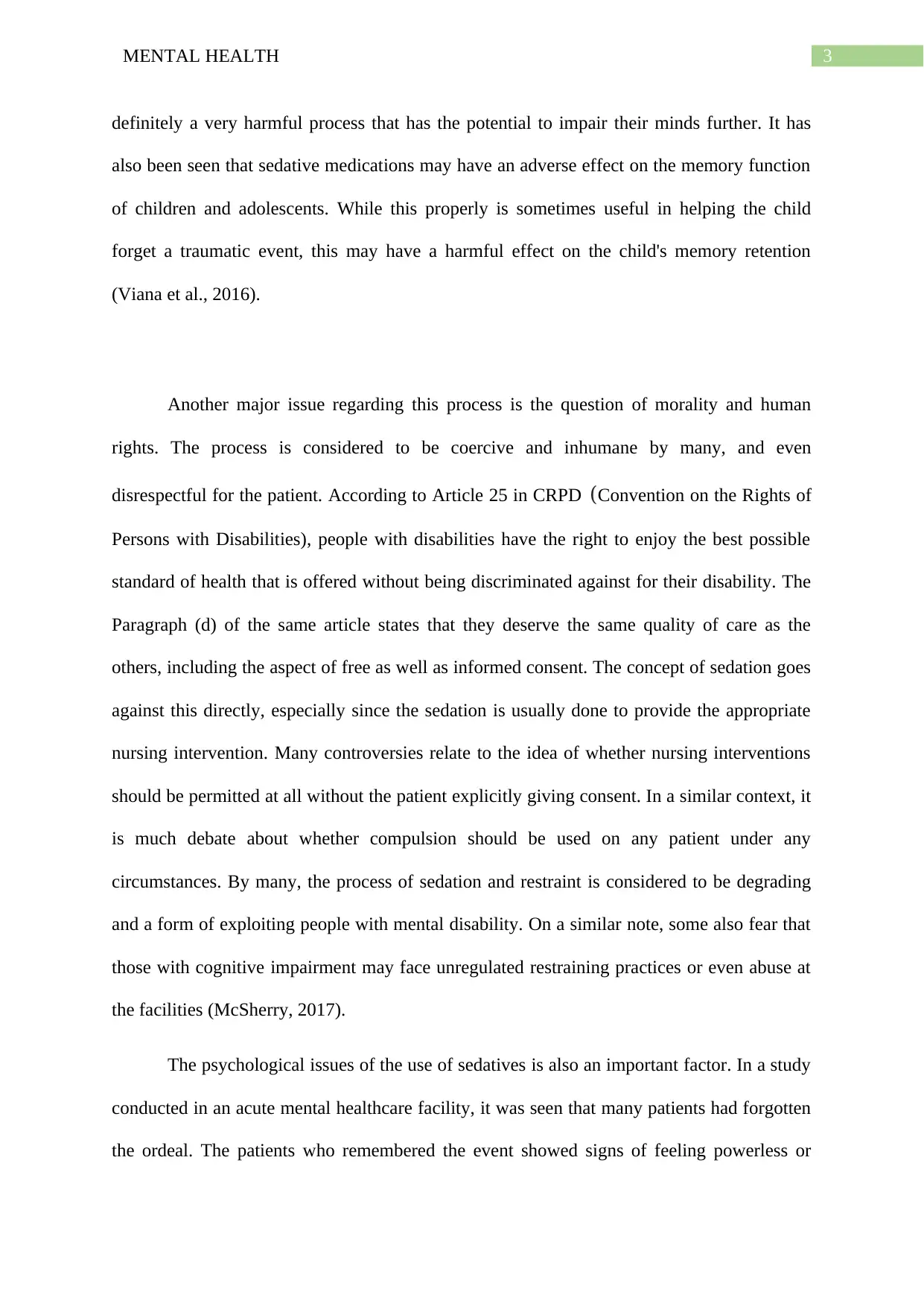
3MENTAL HEALTH
definitely a very harmful process that has the potential to impair their minds further. It has
also been seen that sedative medications may have an adverse effect on the memory function
of children and adolescents. While this properly is sometimes useful in helping the child
forget a traumatic event, this may have a harmful effect on the child's memory retention
(Viana et al., 2016).
Another major issue regarding this process is the question of morality and human
rights. The process is considered to be coercive and inhumane by many, and even
disrespectful for the patient. According to Article 25 in CRPD (Convention on the Rights of
Persons with Disabilities), people with disabilities have the right to enjoy the best possible
standard of health that is offered without being discriminated against for their disability. The
Paragraph (d) of the same article states that they deserve the same quality of care as the
others, including the aspect of free as well as informed consent. The concept of sedation goes
against this directly, especially since the sedation is usually done to provide the appropriate
nursing intervention. Many controversies relate to the idea of whether nursing interventions
should be permitted at all without the patient explicitly giving consent. In a similar context, it
is much debate about whether compulsion should be used on any patient under any
circumstances. By many, the process of sedation and restraint is considered to be degrading
and a form of exploiting people with mental disability. On a similar note, some also fear that
those with cognitive impairment may face unregulated restraining practices or even abuse at
the facilities (McSherry, 2017).
The psychological issues of the use of sedatives is also an important factor. In a study
conducted in an acute mental healthcare facility, it was seen that many patients had forgotten
the ordeal. The patients who remembered the event showed signs of feeling powerless or
definitely a very harmful process that has the potential to impair their minds further. It has
also been seen that sedative medications may have an adverse effect on the memory function
of children and adolescents. While this properly is sometimes useful in helping the child
forget a traumatic event, this may have a harmful effect on the child's memory retention
(Viana et al., 2016).
Another major issue regarding this process is the question of morality and human
rights. The process is considered to be coercive and inhumane by many, and even
disrespectful for the patient. According to Article 25 in CRPD (Convention on the Rights of
Persons with Disabilities), people with disabilities have the right to enjoy the best possible
standard of health that is offered without being discriminated against for their disability. The
Paragraph (d) of the same article states that they deserve the same quality of care as the
others, including the aspect of free as well as informed consent. The concept of sedation goes
against this directly, especially since the sedation is usually done to provide the appropriate
nursing intervention. Many controversies relate to the idea of whether nursing interventions
should be permitted at all without the patient explicitly giving consent. In a similar context, it
is much debate about whether compulsion should be used on any patient under any
circumstances. By many, the process of sedation and restraint is considered to be degrading
and a form of exploiting people with mental disability. On a similar note, some also fear that
those with cognitive impairment may face unregulated restraining practices or even abuse at
the facilities (McSherry, 2017).
The psychological issues of the use of sedatives is also an important factor. In a study
conducted in an acute mental healthcare facility, it was seen that many patients had forgotten
the ordeal. The patients who remembered the event showed signs of feeling powerless or
Secure Best Marks with AI Grader
Need help grading? Try our AI Grader for instant feedback on your assignments.
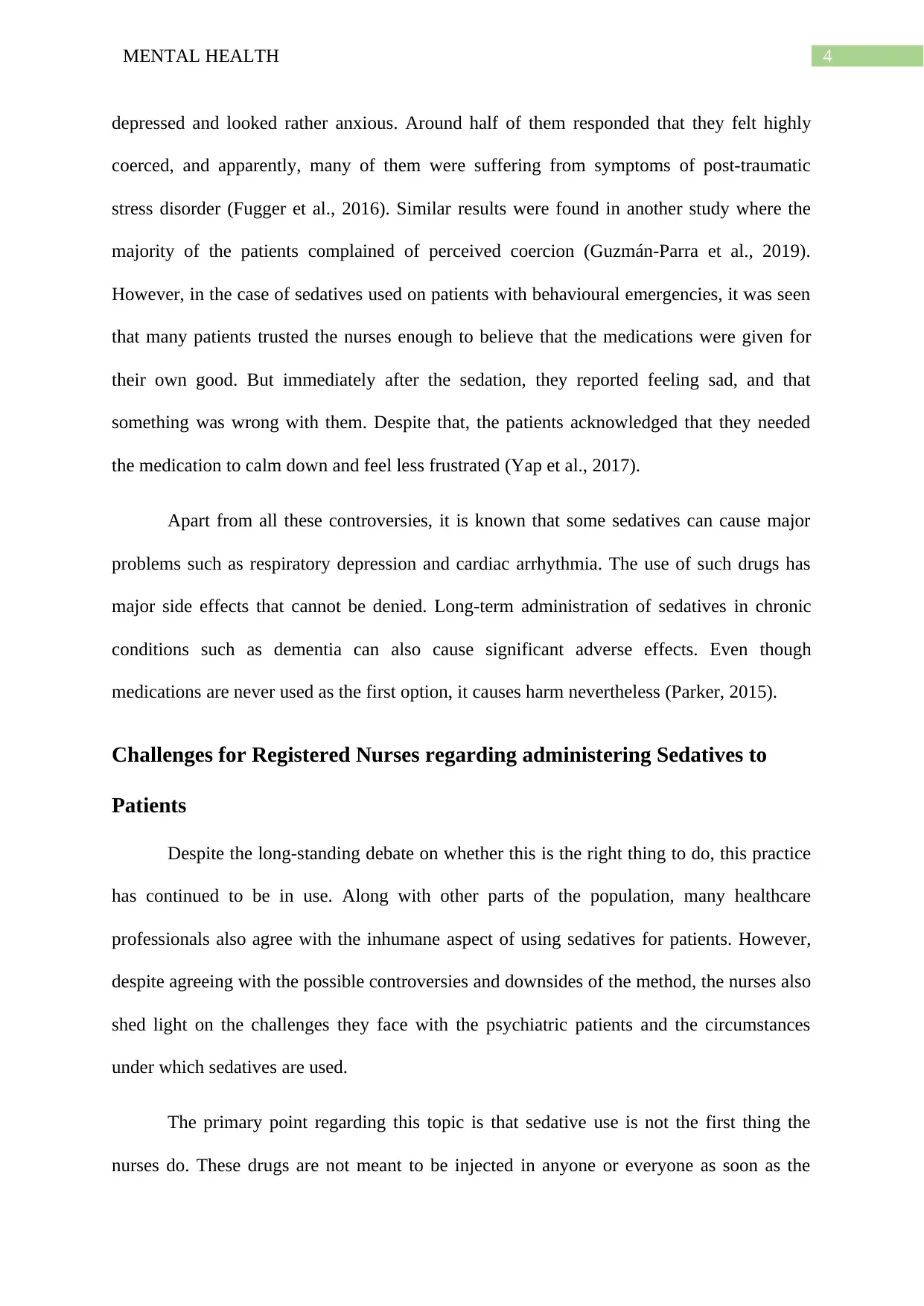
4MENTAL HEALTH
depressed and looked rather anxious. Around half of them responded that they felt highly
coerced, and apparently, many of them were suffering from symptoms of post-traumatic
stress disorder (Fugger et al., 2016). Similar results were found in another study where the
majority of the patients complained of perceived coercion (Guzmán‐Parra et al., 2019).
However, in the case of sedatives used on patients with behavioural emergencies, it was seen
that many patients trusted the nurses enough to believe that the medications were given for
their own good. But immediately after the sedation, they reported feeling sad, and that
something was wrong with them. Despite that, the patients acknowledged that they needed
the medication to calm down and feel less frustrated (Yap et al., 2017).
Apart from all these controversies, it is known that some sedatives can cause major
problems such as respiratory depression and cardiac arrhythmia. The use of such drugs has
major side effects that cannot be denied. Long-term administration of sedatives in chronic
conditions such as dementia can also cause significant adverse effects. Even though
medications are never used as the first option, it causes harm nevertheless (Parker, 2015).
Challenges for Registered Nurses regarding administering Sedatives to
Patients
Despite the long-standing debate on whether this is the right thing to do, this practice
has continued to be in use. Along with other parts of the population, many healthcare
professionals also agree with the inhumane aspect of using sedatives for patients. However,
despite agreeing with the possible controversies and downsides of the method, the nurses also
shed light on the challenges they face with the psychiatric patients and the circumstances
under which sedatives are used.
The primary point regarding this topic is that sedative use is not the first thing the
nurses do. These drugs are not meant to be injected in anyone or everyone as soon as the
depressed and looked rather anxious. Around half of them responded that they felt highly
coerced, and apparently, many of them were suffering from symptoms of post-traumatic
stress disorder (Fugger et al., 2016). Similar results were found in another study where the
majority of the patients complained of perceived coercion (Guzmán‐Parra et al., 2019).
However, in the case of sedatives used on patients with behavioural emergencies, it was seen
that many patients trusted the nurses enough to believe that the medications were given for
their own good. But immediately after the sedation, they reported feeling sad, and that
something was wrong with them. Despite that, the patients acknowledged that they needed
the medication to calm down and feel less frustrated (Yap et al., 2017).
Apart from all these controversies, it is known that some sedatives can cause major
problems such as respiratory depression and cardiac arrhythmia. The use of such drugs has
major side effects that cannot be denied. Long-term administration of sedatives in chronic
conditions such as dementia can also cause significant adverse effects. Even though
medications are never used as the first option, it causes harm nevertheless (Parker, 2015).
Challenges for Registered Nurses regarding administering Sedatives to
Patients
Despite the long-standing debate on whether this is the right thing to do, this practice
has continued to be in use. Along with other parts of the population, many healthcare
professionals also agree with the inhumane aspect of using sedatives for patients. However,
despite agreeing with the possible controversies and downsides of the method, the nurses also
shed light on the challenges they face with the psychiatric patients and the circumstances
under which sedatives are used.
The primary point regarding this topic is that sedative use is not the first thing the
nurses do. These drugs are not meant to be injected in anyone or everyone as soon as the
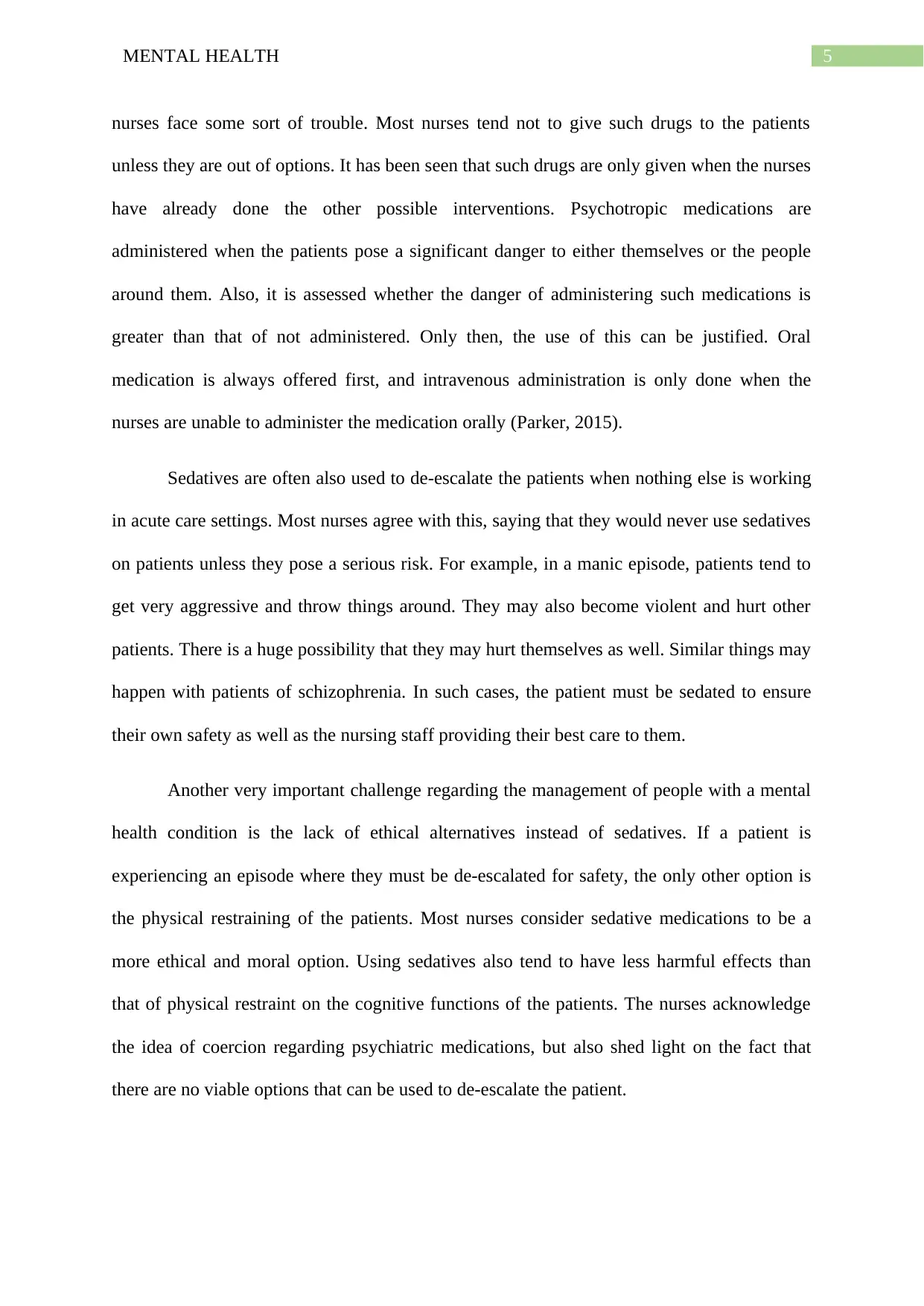
5MENTAL HEALTH
nurses face some sort of trouble. Most nurses tend not to give such drugs to the patients
unless they are out of options. It has been seen that such drugs are only given when the nurses
have already done the other possible interventions. Psychotropic medications are
administered when the patients pose a significant danger to either themselves or the people
around them. Also, it is assessed whether the danger of administering such medications is
greater than that of not administered. Only then, the use of this can be justified. Oral
medication is always offered first, and intravenous administration is only done when the
nurses are unable to administer the medication orally (Parker, 2015).
Sedatives are often also used to de-escalate the patients when nothing else is working
in acute care settings. Most nurses agree with this, saying that they would never use sedatives
on patients unless they pose a serious risk. For example, in a manic episode, patients tend to
get very aggressive and throw things around. They may also become violent and hurt other
patients. There is a huge possibility that they may hurt themselves as well. Similar things may
happen with patients of schizophrenia. In such cases, the patient must be sedated to ensure
their own safety as well as the nursing staff providing their best care to them.
Another very important challenge regarding the management of people with a mental
health condition is the lack of ethical alternatives instead of sedatives. If a patient is
experiencing an episode where they must be de-escalated for safety, the only other option is
the physical restraining of the patients. Most nurses consider sedative medications to be a
more ethical and moral option. Using sedatives also tend to have less harmful effects than
that of physical restraint on the cognitive functions of the patients. The nurses acknowledge
the idea of coercion regarding psychiatric medications, but also shed light on the fact that
there are no viable options that can be used to de-escalate the patient.
nurses face some sort of trouble. Most nurses tend not to give such drugs to the patients
unless they are out of options. It has been seen that such drugs are only given when the nurses
have already done the other possible interventions. Psychotropic medications are
administered when the patients pose a significant danger to either themselves or the people
around them. Also, it is assessed whether the danger of administering such medications is
greater than that of not administered. Only then, the use of this can be justified. Oral
medication is always offered first, and intravenous administration is only done when the
nurses are unable to administer the medication orally (Parker, 2015).
Sedatives are often also used to de-escalate the patients when nothing else is working
in acute care settings. Most nurses agree with this, saying that they would never use sedatives
on patients unless they pose a serious risk. For example, in a manic episode, patients tend to
get very aggressive and throw things around. They may also become violent and hurt other
patients. There is a huge possibility that they may hurt themselves as well. Similar things may
happen with patients of schizophrenia. In such cases, the patient must be sedated to ensure
their own safety as well as the nursing staff providing their best care to them.
Another very important challenge regarding the management of people with a mental
health condition is the lack of ethical alternatives instead of sedatives. If a patient is
experiencing an episode where they must be de-escalated for safety, the only other option is
the physical restraining of the patients. Most nurses consider sedative medications to be a
more ethical and moral option. Using sedatives also tend to have less harmful effects than
that of physical restraint on the cognitive functions of the patients. The nurses acknowledge
the idea of coercion regarding psychiatric medications, but also shed light on the fact that
there are no viable options that can be used to de-escalate the patient.
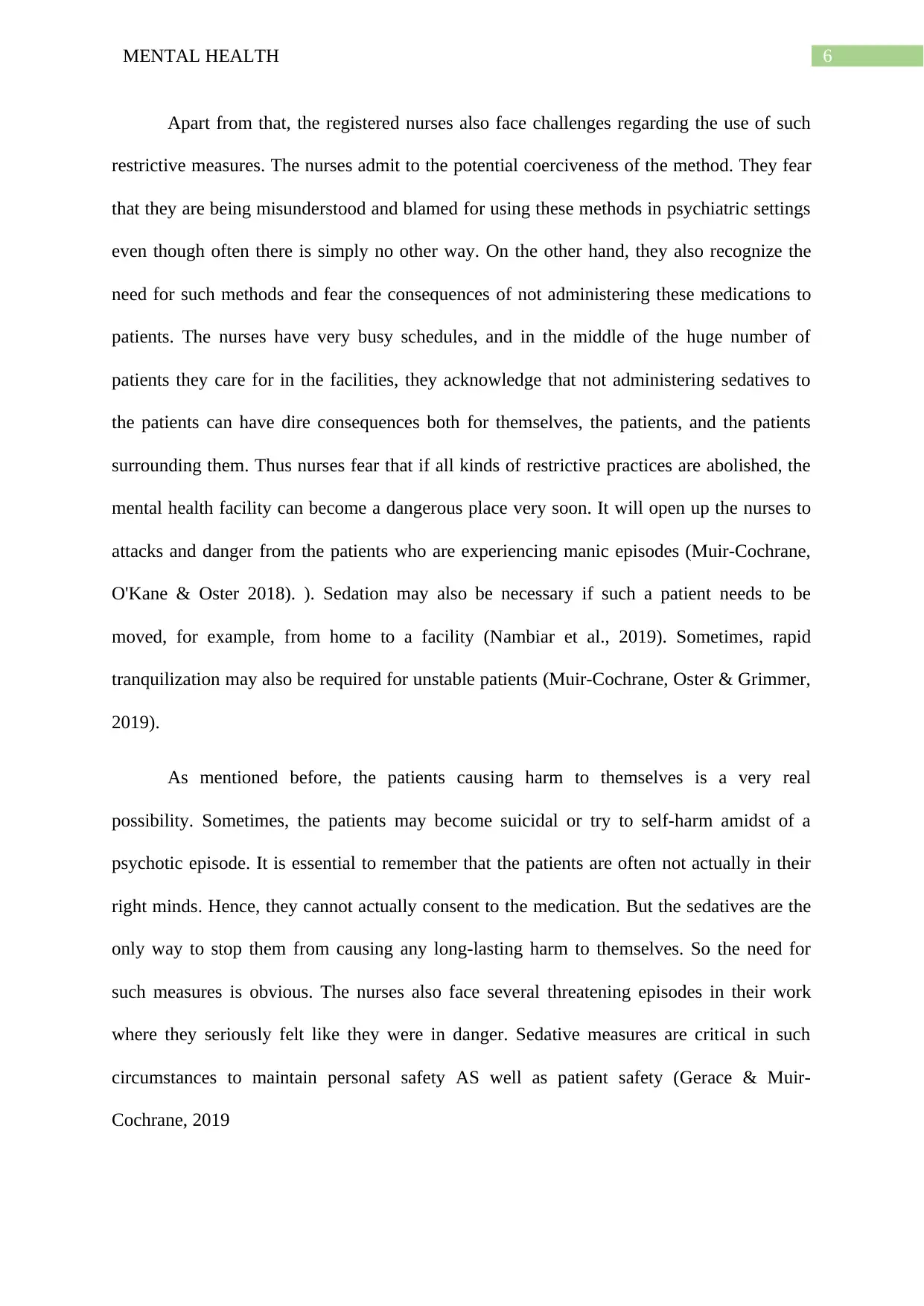
6MENTAL HEALTH
Apart from that, the registered nurses also face challenges regarding the use of such
restrictive measures. The nurses admit to the potential coerciveness of the method. They fear
that they are being misunderstood and blamed for using these methods in psychiatric settings
even though often there is simply no other way. On the other hand, they also recognize the
need for such methods and fear the consequences of not administering these medications to
patients. The nurses have very busy schedules, and in the middle of the huge number of
patients they care for in the facilities, they acknowledge that not administering sedatives to
the patients can have dire consequences both for themselves, the patients, and the patients
surrounding them. Thus nurses fear that if all kinds of restrictive practices are abolished, the
mental health facility can become a dangerous place very soon. It will open up the nurses to
attacks and danger from the patients who are experiencing manic episodes (Muir‐Cochrane,
O'Kane & Oster 2018). ). Sedation may also be necessary if such a patient needs to be
moved, for example, from home to a facility (Nambiar et al., 2019). Sometimes, rapid
tranquilization may also be required for unstable patients (Muir‐Cochrane, Oster & Grimmer,
2019).
As mentioned before, the patients causing harm to themselves is a very real
possibility. Sometimes, the patients may become suicidal or try to self-harm amidst of a
psychotic episode. It is essential to remember that the patients are often not actually in their
right minds. Hence, they cannot actually consent to the medication. But the sedatives are the
only way to stop them from causing any long-lasting harm to themselves. So the need for
such measures is obvious. The nurses also face several threatening episodes in their work
where they seriously felt like they were in danger. Sedative measures are critical in such
circumstances to maintain personal safety AS well as patient safety (Gerace & Muir‐
Cochrane, 2019
Apart from that, the registered nurses also face challenges regarding the use of such
restrictive measures. The nurses admit to the potential coerciveness of the method. They fear
that they are being misunderstood and blamed for using these methods in psychiatric settings
even though often there is simply no other way. On the other hand, they also recognize the
need for such methods and fear the consequences of not administering these medications to
patients. The nurses have very busy schedules, and in the middle of the huge number of
patients they care for in the facilities, they acknowledge that not administering sedatives to
the patients can have dire consequences both for themselves, the patients, and the patients
surrounding them. Thus nurses fear that if all kinds of restrictive practices are abolished, the
mental health facility can become a dangerous place very soon. It will open up the nurses to
attacks and danger from the patients who are experiencing manic episodes (Muir‐Cochrane,
O'Kane & Oster 2018). ). Sedation may also be necessary if such a patient needs to be
moved, for example, from home to a facility (Nambiar et al., 2019). Sometimes, rapid
tranquilization may also be required for unstable patients (Muir‐Cochrane, Oster & Grimmer,
2019).
As mentioned before, the patients causing harm to themselves is a very real
possibility. Sometimes, the patients may become suicidal or try to self-harm amidst of a
psychotic episode. It is essential to remember that the patients are often not actually in their
right minds. Hence, they cannot actually consent to the medication. But the sedatives are the
only way to stop them from causing any long-lasting harm to themselves. So the need for
such measures is obvious. The nurses also face several threatening episodes in their work
where they seriously felt like they were in danger. Sedative measures are critical in such
circumstances to maintain personal safety AS well as patient safety (Gerace & Muir‐
Cochrane, 2019
Paraphrase This Document
Need a fresh take? Get an instant paraphrase of this document with our AI Paraphraser
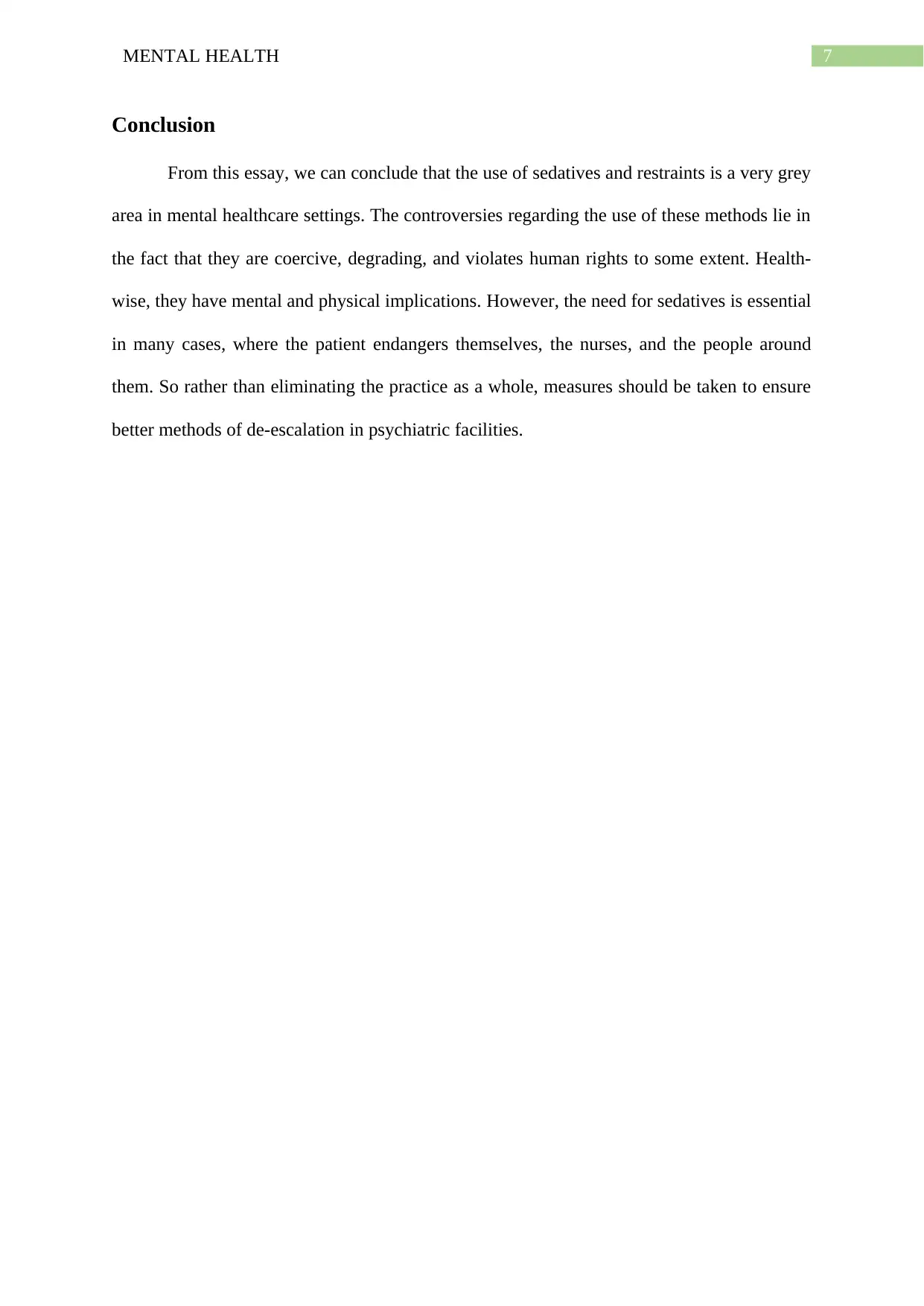
7MENTAL HEALTH
Conclusion
From this essay, we can conclude that the use of sedatives and restraints is a very grey
area in mental healthcare settings. The controversies regarding the use of these methods lie in
the fact that they are coercive, degrading, and violates human rights to some extent. Health-
wise, they have mental and physical implications. However, the need for sedatives is essential
in many cases, where the patient endangers themselves, the nurses, and the people around
them. So rather than eliminating the practice as a whole, measures should be taken to ensure
better methods of de-escalation in psychiatric facilities.
Conclusion
From this essay, we can conclude that the use of sedatives and restraints is a very grey
area in mental healthcare settings. The controversies regarding the use of these methods lie in
the fact that they are coercive, degrading, and violates human rights to some extent. Health-
wise, they have mental and physical implications. However, the need for sedatives is essential
in many cases, where the patient endangers themselves, the nurses, and the people around
them. So rather than eliminating the practice as a whole, measures should be taken to ensure
better methods of de-escalation in psychiatric facilities.
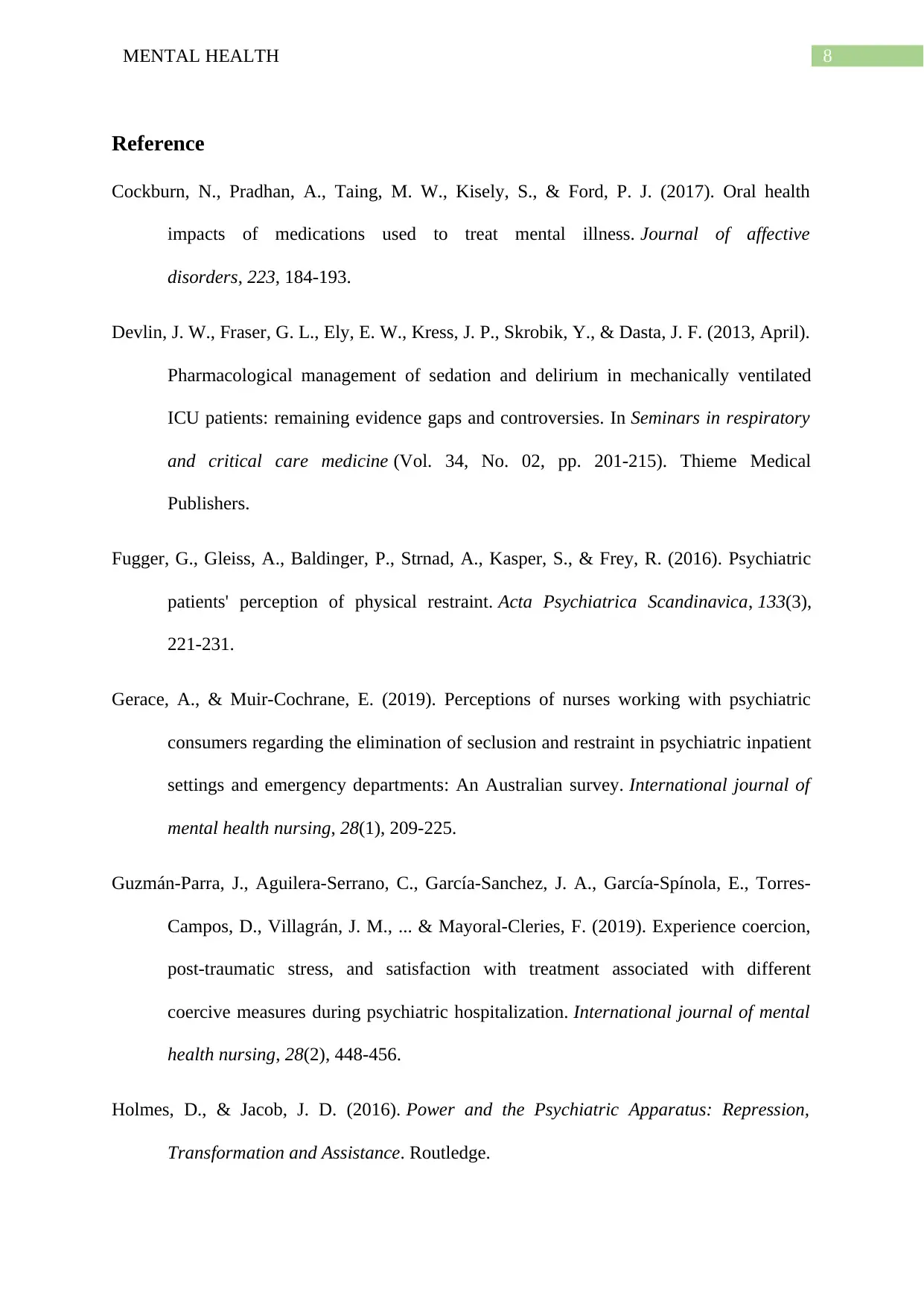
8MENTAL HEALTH
Reference
Cockburn, N., Pradhan, A., Taing, M. W., Kisely, S., & Ford, P. J. (2017). Oral health
impacts of medications used to treat mental illness. Journal of affective
disorders, 223, 184-193.
Devlin, J. W., Fraser, G. L., Ely, E. W., Kress, J. P., Skrobik, Y., & Dasta, J. F. (2013, April).
Pharmacological management of sedation and delirium in mechanically ventilated
ICU patients: remaining evidence gaps and controversies. In Seminars in respiratory
and critical care medicine (Vol. 34, No. 02, pp. 201-215). Thieme Medical
Publishers.
Fugger, G., Gleiss, A., Baldinger, P., Strnad, A., Kasper, S., & Frey, R. (2016). Psychiatric
patients' perception of physical restraint. Acta Psychiatrica Scandinavica, 133(3),
221-231.
Gerace, A., & Muir‐Cochrane, E. (2019). Perceptions of nurses working with psychiatric
consumers regarding the elimination of seclusion and restraint in psychiatric inpatient
settings and emergency departments: An Australian survey. International journal of
mental health nursing, 28(1), 209-225.
Guzmán‐Parra, J., Aguilera‐Serrano, C., García‐Sanchez, J. A., García‐Spínola, E., Torres‐
Campos, D., Villagrán, J. M., ... & Mayoral‐Cleries, F. (2019). Experience coercion,
post‐traumatic stress, and satisfaction with treatment associated with different
coercive measures during psychiatric hospitalization. International journal of mental
health nursing, 28(2), 448-456.
Holmes, D., & Jacob, J. D. (2016). Power and the Psychiatric Apparatus: Repression,
Transformation and Assistance. Routledge.
Reference
Cockburn, N., Pradhan, A., Taing, M. W., Kisely, S., & Ford, P. J. (2017). Oral health
impacts of medications used to treat mental illness. Journal of affective
disorders, 223, 184-193.
Devlin, J. W., Fraser, G. L., Ely, E. W., Kress, J. P., Skrobik, Y., & Dasta, J. F. (2013, April).
Pharmacological management of sedation and delirium in mechanically ventilated
ICU patients: remaining evidence gaps and controversies. In Seminars in respiratory
and critical care medicine (Vol. 34, No. 02, pp. 201-215). Thieme Medical
Publishers.
Fugger, G., Gleiss, A., Baldinger, P., Strnad, A., Kasper, S., & Frey, R. (2016). Psychiatric
patients' perception of physical restraint. Acta Psychiatrica Scandinavica, 133(3),
221-231.
Gerace, A., & Muir‐Cochrane, E. (2019). Perceptions of nurses working with psychiatric
consumers regarding the elimination of seclusion and restraint in psychiatric inpatient
settings and emergency departments: An Australian survey. International journal of
mental health nursing, 28(1), 209-225.
Guzmán‐Parra, J., Aguilera‐Serrano, C., García‐Sanchez, J. A., García‐Spínola, E., Torres‐
Campos, D., Villagrán, J. M., ... & Mayoral‐Cleries, F. (2019). Experience coercion,
post‐traumatic stress, and satisfaction with treatment associated with different
coercive measures during psychiatric hospitalization. International journal of mental
health nursing, 28(2), 448-456.
Holmes, D., & Jacob, J. D. (2016). Power and the Psychiatric Apparatus: Repression,
Transformation and Assistance. Routledge.
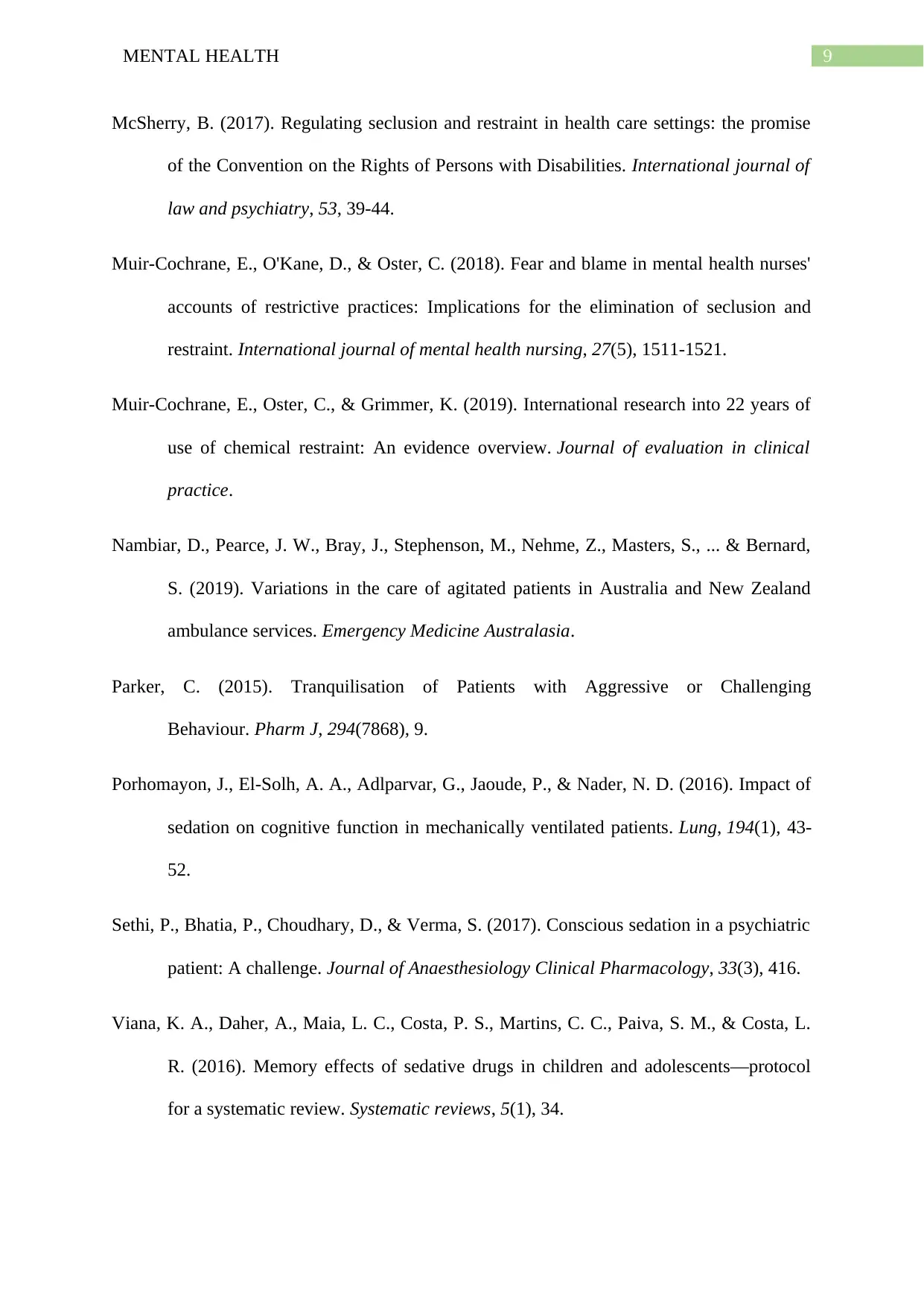
9MENTAL HEALTH
McSherry, B. (2017). Regulating seclusion and restraint in health care settings: the promise
of the Convention on the Rights of Persons with Disabilities. International journal of
law and psychiatry, 53, 39-44.
Muir‐Cochrane, E., O'Kane, D., & Oster, C. (2018). Fear and blame in mental health nurses'
accounts of restrictive practices: Implications for the elimination of seclusion and
restraint. International journal of mental health nursing, 27(5), 1511-1521.
Muir‐Cochrane, E., Oster, C., & Grimmer, K. (2019). International research into 22 years of
use of chemical restraint: An evidence overview. Journal of evaluation in clinical
practice.
Nambiar, D., Pearce, J. W., Bray, J., Stephenson, M., Nehme, Z., Masters, S., ... & Bernard,
S. (2019). Variations in the care of agitated patients in Australia and New Zealand
ambulance services. Emergency Medicine Australasia.
Parker, C. (2015). Tranquilisation of Patients with Aggressive or Challenging
Behaviour. Pharm J, 294(7868), 9.
Porhomayon, J., El-Solh, A. A., Adlparvar, G., Jaoude, P., & Nader, N. D. (2016). Impact of
sedation on cognitive function in mechanically ventilated patients. Lung, 194(1), 43-
52.
Sethi, P., Bhatia, P., Choudhary, D., & Verma, S. (2017). Conscious sedation in a psychiatric
patient: A challenge. Journal of Anaesthesiology Clinical Pharmacology, 33(3), 416.
Viana, K. A., Daher, A., Maia, L. C., Costa, P. S., Martins, C. C., Paiva, S. M., & Costa, L.
R. (2016). Memory effects of sedative drugs in children and adolescents—protocol
for a systematic review. Systematic reviews, 5(1), 34.
McSherry, B. (2017). Regulating seclusion and restraint in health care settings: the promise
of the Convention on the Rights of Persons with Disabilities. International journal of
law and psychiatry, 53, 39-44.
Muir‐Cochrane, E., O'Kane, D., & Oster, C. (2018). Fear and blame in mental health nurses'
accounts of restrictive practices: Implications for the elimination of seclusion and
restraint. International journal of mental health nursing, 27(5), 1511-1521.
Muir‐Cochrane, E., Oster, C., & Grimmer, K. (2019). International research into 22 years of
use of chemical restraint: An evidence overview. Journal of evaluation in clinical
practice.
Nambiar, D., Pearce, J. W., Bray, J., Stephenson, M., Nehme, Z., Masters, S., ... & Bernard,
S. (2019). Variations in the care of agitated patients in Australia and New Zealand
ambulance services. Emergency Medicine Australasia.
Parker, C. (2015). Tranquilisation of Patients with Aggressive or Challenging
Behaviour. Pharm J, 294(7868), 9.
Porhomayon, J., El-Solh, A. A., Adlparvar, G., Jaoude, P., & Nader, N. D. (2016). Impact of
sedation on cognitive function in mechanically ventilated patients. Lung, 194(1), 43-
52.
Sethi, P., Bhatia, P., Choudhary, D., & Verma, S. (2017). Conscious sedation in a psychiatric
patient: A challenge. Journal of Anaesthesiology Clinical Pharmacology, 33(3), 416.
Viana, K. A., Daher, A., Maia, L. C., Costa, P. S., Martins, C. C., Paiva, S. M., & Costa, L.
R. (2016). Memory effects of sedative drugs in children and adolescents—protocol
for a systematic review. Systematic reviews, 5(1), 34.
Secure Best Marks with AI Grader
Need help grading? Try our AI Grader for instant feedback on your assignments.
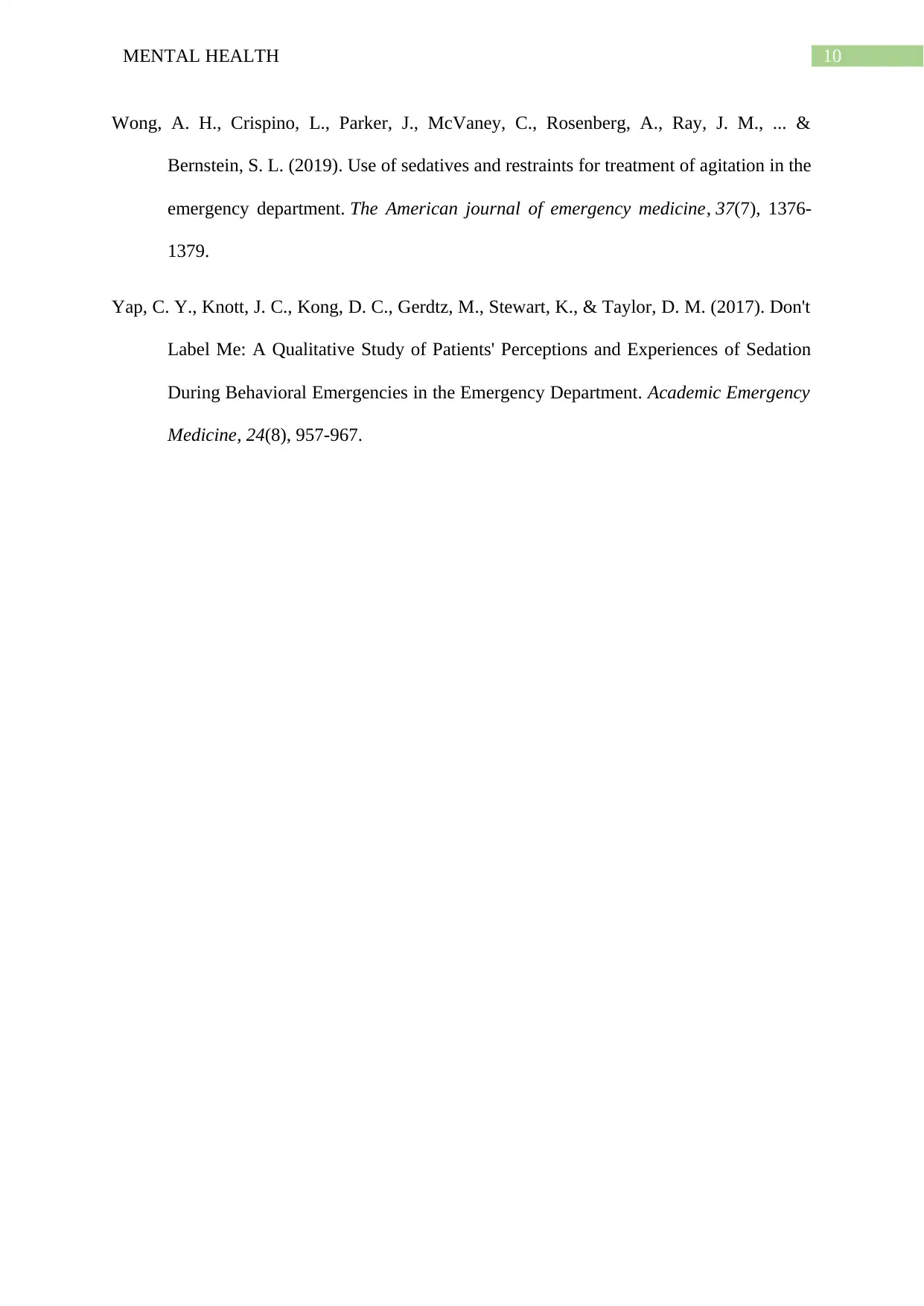
10MENTAL HEALTH
Wong, A. H., Crispino, L., Parker, J., McVaney, C., Rosenberg, A., Ray, J. M., ... &
Bernstein, S. L. (2019). Use of sedatives and restraints for treatment of agitation in the
emergency department. The American journal of emergency medicine, 37(7), 1376-
1379.
Yap, C. Y., Knott, J. C., Kong, D. C., Gerdtz, M., Stewart, K., & Taylor, D. M. (2017). Don't
Label Me: A Qualitative Study of Patients' Perceptions and Experiences of Sedation
During Behavioral Emergencies in the Emergency Department. Academic Emergency
Medicine, 24(8), 957-967.
Wong, A. H., Crispino, L., Parker, J., McVaney, C., Rosenberg, A., Ray, J. M., ... &
Bernstein, S. L. (2019). Use of sedatives and restraints for treatment of agitation in the
emergency department. The American journal of emergency medicine, 37(7), 1376-
1379.
Yap, C. Y., Knott, J. C., Kong, D. C., Gerdtz, M., Stewart, K., & Taylor, D. M. (2017). Don't
Label Me: A Qualitative Study of Patients' Perceptions and Experiences of Sedation
During Behavioral Emergencies in the Emergency Department. Academic Emergency
Medicine, 24(8), 957-967.
1 out of 11
Related Documents
Your All-in-One AI-Powered Toolkit for Academic Success.
+13062052269
info@desklib.com
Available 24*7 on WhatsApp / Email
![[object Object]](/_next/static/media/star-bottom.7253800d.svg)
Unlock your academic potential
© 2024 | Zucol Services PVT LTD | All rights reserved.





